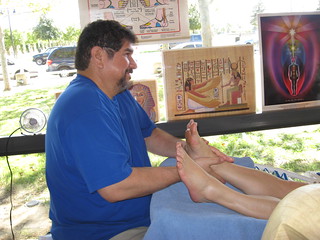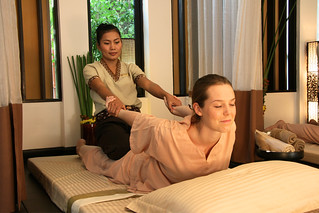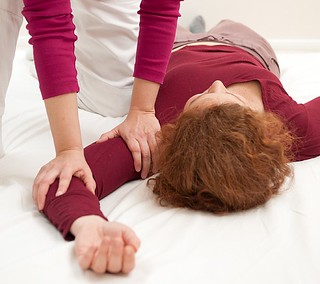Maybe you have seen or heard the term “ashiatsu”.
Your massage therapist or spa started offering it, or a friend / family member recently raved about it.
You might be a massage therapist and have been hearing colleagues talk about the benefits of this technique for both you and your clients.
Whoever you are – you’re curious now, and you want to learn more about ashiatsu.
There are a few other modalities (massage techniques) people commonly confuse ashiatsu with. If it is not a Swedish, relaxation, or deep tissue massage, then what is it? Today, let’s clear this up and talk about somethings that ashiatsu is not.
Ashiatsu is not Reflexology
“Oh, ashiatsu. That is where they massage your feet, right? Yeah, I’ve had that before. My feet felt great afterwards.”
 Reflexology is based on a theory that areas of the feet correspond to certain areas of the body. During a reflexology (or zone therapy) session, the practitioner applies pressure to specific points on the feet, hands, or ears. Reflexologists believe applying pressure to these specific points on the foot will bring physical change to the corresponding part of the body.
Reflexology is based on a theory that areas of the feet correspond to certain areas of the body. During a reflexology (or zone therapy) session, the practitioner applies pressure to specific points on the feet, hands, or ears. Reflexologists believe applying pressure to these specific points on the foot will bring physical change to the corresponding part of the body.
Ashiatsu is quite different. During an ashiatsu massage, the therapist uses their feet to massage the client. The feet are massaged too, but with the practitioners feet. With the exception of the face and stomach, the massage practitioner can use their feet anywhere they use their hands.
Ashiatsu is not a Thai Massage
“Ashiatsu… I think my yoga instructor demonstrated that last week with another student. It looked like partner yoga.”
 A Thai massage typically takes place with a fully-clothed massage client on a floor mat. This massage is characterized by the practitioner leading the client through a series of assisted stretches. These stretches are combined with a compression-style massage. No lotions, oils, or massage creams are used during Thai massage. A Thai practitioner may also use their feet to apply compressions during the session.
A Thai massage typically takes place with a fully-clothed massage client on a floor mat. This massage is characterized by the practitioner leading the client through a series of assisted stretches. These stretches are combined with a compression-style massage. No lotions, oils, or massage creams are used during Thai massage. A Thai practitioner may also use their feet to apply compressions during the session.
An ashiatsu massage takes place on a regular massage table; the kind most people are familiar with lying on during a massage. Clients are are allowed to disrobe to their comfort level and are covered with a sheet. The massage practitioner holds on to a set of bars suspended from the ceiling, which are used for balance. Most massage professionals will keep one foot on the table while the other foot is used to apply long, broad massage strokes. A lotion, oil, or cream will be used. There are derivative forms of ashiatsu that do use Thai-style stretches during the massage, but it is not typical.
Ashiatsu is not Shiatsu
“Ashiatsu? Is that the massage they do in Japan with the all of the points on the body?”
 Shiatsu, like Thai massage, takes place with a fully-clothed client on a floor mat/table no massage lubricants. Shiatsu involves a thorough study of Eastern medicine and the meridian system. The practitioner will use this knowledge to apply finger pressure (“shi” = finger and “atsu” = pressure) to certain areas in order to bring a positive change to the body. Some shiatsu practitioners will use their feet to apply pressure to needed areas. They may also use their thumbs, palms, elbows, or knees.
Shiatsu, like Thai massage, takes place with a fully-clothed client on a floor mat/table no massage lubricants. Shiatsu involves a thorough study of Eastern medicine and the meridian system. The practitioner will use this knowledge to apply finger pressure (“shi” = finger and “atsu” = pressure) to certain areas in order to bring a positive change to the body. Some shiatsu practitioners will use their feet to apply pressure to needed areas. They may also use their thumbs, palms, elbows, or knees.
Shiatsu and ashiatsu are similar in name, but different different in many ways. Barefoot massage certainly originated in East, but ashiatsu is heavily influenced by modern, Western massage. Massage practitioners in the United States are typically trained in Western, Swedish-style massage techniques. Most will use static pressure on “trigger points” when needed.
Are you ready to try it?
Quite simply, ashiatsu is like most common forms of massage that Americans are familiar with. The only difference is that you are trading the massage therapist’s hands for their feet. This switch allows the practitioner to
- deliver long, consistent, and smooth massage strokes
- use gravity for a deeper massage, when needed
- and yes, even give their hands a temporary rest.
But, this rest of the professional’s hands does not result in a downgrade for the client.
Many massage clients report ashiatsu provides even more pain relief than other common massage modalities/techniques, while still allowing them to relax. It is also common to hear that the use of the practitioner’s feet causes less pain because of the broad surface of the foot/heel. I have found that once clients try an ashiatsu massage, they have a hard time receiving a “regular” massage anywhere else again.
If you are ready to try ashiatsu, seek a qualified massage professional in your area.
Massage professionals interested in ashiatsu training can learn more here.
I love the sound of Ashiatsu massage and really want to train in it. I live in the UK and I can’t seem to find anywhere that gives a course in this. Can anyone help me?
I have had several requests for UK trainings lately. The closest thing you have there is Chavutti. Here is a website with some UK Chavutti practitioners – http://www.helennoakes.net/chavutti-thirumal-massage/graduates/. If there are any UK ashiatsu practitioners – speak up here!
Hi, I would love to train in this! Did you find a UK teacher please?
Check out Helen Noakes in UK for Chavutti. At this time I am not aware of any UK ashi instructors. That is why I have quite a few UK practitioners take the online course.
Hey there, first of all thank you so much for this post and honestly I was searching for the same information from last few days. Keep posting and keep sharing.